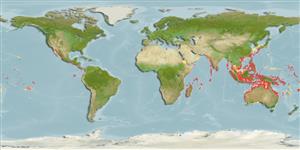Common names from other countries
>
Eupercaria/misc (Various families in series Eupercaria) >
Labridae (Wrasses) > Corinae
Etymology: Pseudocoris: Greek, pseudes = false + Greek, kore = pupil (Ref. 45335).
More on author: Bleeker.
Environment: milieu / climate zone / depth range / distribution range
Ecologia
marinhas associadas(os) a recifes; não migratória; intervalo de profundidade 2 - 54 m (Ref. 86942), usually 15 - 24 m (Ref. 90102). Tropical
Pacific Ocean: from the Line Islands to Indonesia, north to Taiwan and southern Japan, and south to the Great Barrier Reef.
Tamanho / Peso / Idade
Maturity: Lm ? range ? - ? cm
Max length : 20.0 cm TL macho/indeterminado; (Ref. 9710); common length : 15.0 cm SL macho/indeterminado; (Ref. 37816)
Descrição suscinta
Chaves de identificação | Morfologia | Morfometria
Espinhos dorsais (total) : 9; Raios dorsais (total) : 12; Espinhos anais: 3; Raios anais : 12. Color changes quickly from when moving from swimming near the bottom to open water to feed and the striped pattern of the female fades to an even grey that makes them difficult to see. Males have a variable banded pattern and this also changes with moods (Ref. 48636).
Found in outer reef crests in small aggregations (Ref. 8631). Females occur in small groups, and usually a male is nearby (Ref. 48636). Usually well above open bottoms with mixed sand, rubble, and coral (Ref. 9710). Found in areas periodically exposed to strong currents (Ref. 90102). Feeds on zooplankton (Ref. 9710).
Ciclo de vida ou comportamento de acasalamento
Maturities | Reprodução | Spawnings | Egg(s) | Fecundities | Larvas
Oviparous, distinct pairing during breeding (Ref. 205).
Kailola, P.J., 1987. The fishes of Papua New Guinea: a revised and annotated checklist. Vol. II Scorpaenidae to Callionymidae. Research Bulletin No. 41, Research Section, Dept. of Fisheries and Marine Resources, Papua New Guinea. (Ref. 6192)
Status na Lista Vermelha da UICN (Ref. 130435)
Warning: mysqli::__construct(): (HY000/1040): Too many connections in /var/www/html/includes/func_getlabel.php on line 46
Can't connect to MySQL database (fbapp). Errorcode: Too many connections
